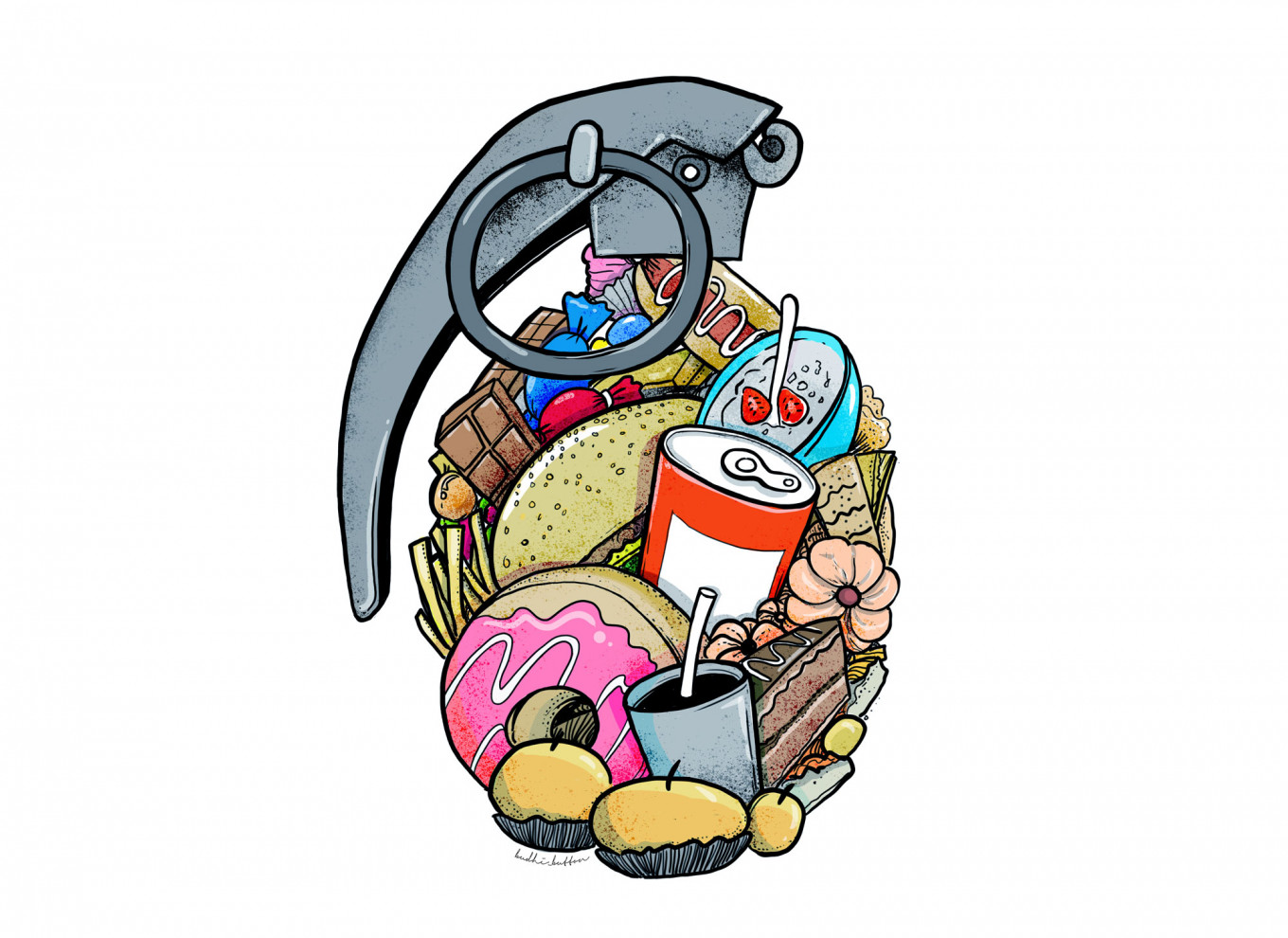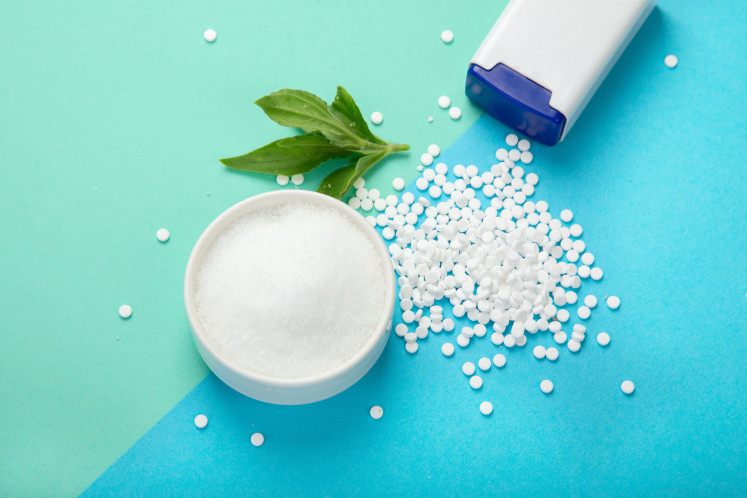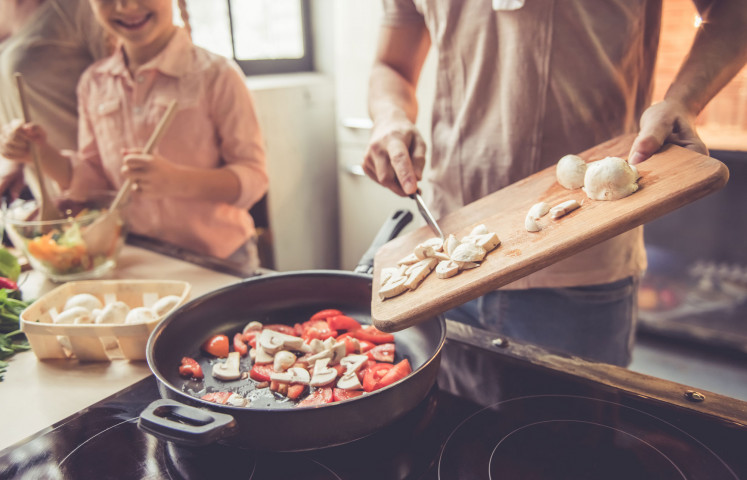(Courtesy of Shutterstock)
The echoes of the recent Idul Fitri festivities may now be fading, but the aftermath of our culinary indulgences, particularly the sugary delights that graced our celebratory spreads, still lingers.
One of the most widely cited studies of sugar consumption in Indonesia, the Health Ministry’s Total Diet Study in 2014, stated that 11.8 percent of the population consumes over 50 grams of sugar per day. And that number is certainly higher now, with the consumption of sugar-sweetened food and beverages on the rise.
The problem is that these numbers exceed the limits that doctors recommend. According to the American Heart Association, the recommended daily consumption for male adults is nine teaspoons, or 36 g, of added sugar, and for female adults it is six teaspoons, or 25 g of added sugar.
Nutrition specialist I Yuwanda Chrissander from the Grand Family Maternity and Pediatrics Hospital in North Jakarta emphasizes that this recommendation applies to added sugars, which are sugars and syrups added to foods and beverages during processing or preparation.
“Naturally occurring sugars found in fruit, vegetables and dairy products are not included in these guidelines, as they come with beneficial nutrients like fiber, vitamins and minerals,” he said.
In general, the recommended daily intake of added sugar should account for no more than 10 percent of total daily calories. For an average adult consuming about 2,000 calories per day, this would equate to approximately 50 g, or 12 teaspoons, of added sugar.

Thank you!
For signing up to our newsletter.
Please check your email for your newsletter subscription.
Read also: How women fare in IndonesiaHunting down hidden sugar
But how do we measure our added sugar intake? According to Vikie Nouvrisia Anandaputri, a practicing doctor specializing in nutrition at Mayapada Hospital Bogor in West Java, we can pay attention to the sugar content in the packaged food and drinks we consume.
The three-in-one coffee mix we consume every morning can already account for 13 g of added sugar, more than half the limit for adult women.
In just one 100-gram bar of milk chocolate, there could be 40-60 g of sugar, which already exceeds the recommended daily limit.
“Even seemingly innocent fruit juices and mixes can have 40-60 g per serving, which is more than some pastries [which typically have around 5-6 g per small serving],” Vikie said.
Bottled tea drinks, for example, can pack a whopping 20 g of sugar per 350-mililiter bottle, while a 250 ml can of regular soda could easily have at least 26 g of sugar.
But making homemade versions of the drinks might not be entirely safer either. For instance, a glass of iced tea at home can contain two tablespoons of sugar.
“Sugar can also be ‘hiding’ in various foods and drinks, sometimes even in things that don't taste particularly sweet,” Vikie said.
A single tablespoon of kecap manis, for example, can already have as much as 10 g of sugar. One serving of commercial sambal (chili sauce) can already take up 5 g out of your daily limit.
That flavored yogurt that you consume as a healthy snack? Check the label, because it can easily have 10 g of sugar per serving.
Sugary rollercoaster
During the recent Ramadan, sugary consumption among Indonesians increased significantly due to the cherished tradition of buka manis (breaking the fast with something sweet), as streets came alive with takjil (breaking-of-the-fast snack) vendors offering a dazzling array of sugary treats.
One example of favorite among Indonesians for iftar is kolak pisang, a traditional sweet banana drink. Consider a recipe using 100 ml of coconut milk, then adding one banana of approximately 50 g in weight and palm sugar, the total sugar content can reach an estimated 26-30 g. However, this amount can vary depending on the specific quantities of each ingredient used in the recipe.
Many opt for the sugary treats due to their palate, but some simply assume that sweet treats, especially in fluid forms, are the best way to break the fast to re-fuel a dehydrated body. Sweet treats might be tempting after a long fast, but they can lead to a sugar rollercoaster.
"When we fast, our blood sugar drops, and breaking the fast is when we bring our blood sugar levels to normal by consuming sweet foods. However, the type of sweetness must be chosen carefully," said Olivia Gresya, a registered nutritionist currently practicing at the Siloam Hospital Purwakarta.
According to Olivia, unlike complex carbohydrates in whole grains that give steady energy, sugary pastries and packaged drinks, with simple carbs, cause blood sugar to spike and crash quickly. This is not ideal for human bodies.
“Have you ever felt that when you break your fast, instead of feeling refreshed because your blood sugar levels have stabilized, you feel weak, sleepy and uninspired? Well, this is because blood sugar levels rise and fall quickly, and energy is lost more quickly.”
A sweeter combination of a glass of water and sweet fruits like dates is more recommended, as these can gently nudge blood sugar levels back up, unlike the quick spike sugary drinks can cause. As a bonus, fruit comes loaded with vitamins, antioxidants and fiber.
Read also: The Great Nastar Debacle
Finding a sweet balance
The key is to balance things out. Yuwanda suggested focusing on consuming sugars in moderation and as part of a well-balanced diet.
“This means prioritizing whole, nutrient-dense foods and beverages while limiting the intake of processed and sugary items. By being mindful of overall sugar intake and considering individual factors, individuals can make choices that support their health and well-being,” he said.
A simple trick is to add some colorful vegetables to the plate, advised Olivia. Veggies are packed with fiber, which helps the body feel fuller for longer and keeps cholesterol in check.
Dishes made with coconut milk, like opor ayam (chicken in coconut milk), rendang (spicy beef) and gulai labu siam (pumpkin goulash), can still be part of the party too, but avoid reheating them repeatedly. This can increase the saturated fat content, which is not ideal.
The star of the dessert table, traditional sweet Indonesian snacks like nastar, kaastengel, and putri salju, can be another trap. Olivia revealed that eating 10 pieces of nastar can add up to 375 calories, almost as much as half a plate of rice, complete with side dishes, vegetables and fruit.
She said that one piece of kaastengel averages 21 kcal, and the sugar is 0.06 g, while one piece of nastar averages 75 kcal, and the sugar is 3.5 g. One piece of putri salju averages 30 kcal, and the sugar is 0.16 g.
This is why limiting consumption to two to three pieces daily is a great way to satisfy the sweet tooth without going overboard.
The good news? Everyone is in control of their daily sugar intake.
“Eid moments [are filled] with food like this [and we] don't have to make us torture ourselves by not consuming it,” said Olivia. “Just remember that when the Eid moment is over, we need to return to a healthy diet with balanced nutrition. [A healthy] diet does not mean you are not allowed to eat, but how we control food intake with balance.”
For those with a sweet tooth, it is wiser to keep the range of sweet treats and drinks consumed in a day as varied as possible. Think fruit, yogurt parfaits or whole-wheat bread with peanut butter.
For those feeling like their post-festivities clothes are a bit snug, portion control the plate using the T-plate concept. One quarter should be filled with complex carbs like rice, corn or potatoes to fuel the metabolism. Another quarter is for protein power, think of lean meats, fish, or tofu and beans. Then, fill the remaining half with veggies and fruits.
Making healthy choices can help keep the body functioning at its best, avoiding the risk of diabetes down the line. Diabetes used to be more common in older folks, but sedentary lifestyles and sugary diets have made it a risk for younger people too.
In addition to healthy meals, Vikie reminds everyone not to be a couch potato and schedule some fun activities three-to-five times a week, even if it is just for 15-30 minutes. Combine a mixture of cardio and muscle training activities to keep the body in shape.
Tips to reduce your sugar intake
You do not have to go cold turkey. Nutrition specialist Yuwanda shared the following safe and effective strategies to reduce your sugar intake.
- Choose whole foods: Opt for whole, unprocessed foods such as fruit, vegetables, whole grains, lean proteins and dairy products. These foods contain natural sugars along with essential nutrients like fiber, vitamins and minerals.
(Courtesy of Shutterstock)
- Read labels: Pay close attention to nutrition labels when shopping for packaged foods and beverages. Look for products with minimal added sugars and choose those with lower sugar content per serving.
(Courtesy of Shutterstock)
- Limit sugary beverages: Cut back on sugary drinks such as soda, fruit juices, sports drinks and sweetened teas and coffees. Instead, hydrate with water, sparkling water, herbal teas or unsweetened beverages.
(Courtesy of Shutterstock)
- Be mindful of portions: Practice portion control when consuming foods high in added sugars, such as desserts, candies and baked goods. Enjoy these treats in moderation and aim for smaller servings.
(Courtesy of Shutterstock)
- Use natural sweeteners: Experiment with natural sweeteners like stevia, monk fruit extract or erythritol as alternatives to refined sugars. These sweeteners can add sweetness to food and beverages without the same impact on blood sugar levels.
(Courtesy of Shutterstock)
- Cook at home: Prepare meals and snacks at home using whole ingredients to have better control over sugar content. Homemade meals allow you to adjust sweetness levels to your preference while incorporating nutritious ingredients.
(Courtesy of Shutterstock)
- Gradual reduction: Gradually reduce sugar intake over time to allow your taste buds to adjust. Start by cutting back on the amount of sugar added to foods and beverages and gradually decrease reliance on sweet flavors.
(Courtesy of Shutterstock)
Read also: Sprucing Up your Home for a Lebaran Open House
This article is part of The Weekender, which comes out on the Saturday edition of The Jakarta Post. It offers a variety of lifestyle and culture articles aimed at enriching your reading experience. Subscribe
here to get access to the Saturday edition and all other premium content from the Post.






























